The DOTr refers to the Department of Transportation—a government agency responsible for overseeing and implementing policies, projects, and programs related to transportation within the country. The DOTr plays a crucial role in developing and maintaining efficient, safe, and sustainable transportation systems, including road networks, public transportation, aviation, and maritime infrastructure. From land to air and sea, the DOTr serves the public as the main architect for safe, secure, and efficient transportation infrastructures, serving as a linchpin for national and economic progress.
With a legacy dating back to January 23, 1899, the DOTr has long evolved into a powerhouse within the executive branch, orchestrating the development and regulation of the country’s land, air, and sea transportation infrastructure, accelerating the country’s economic development through various reforms. In this article, let’s take a closer look at the Department of Transportation (DOTr) and see the force behind the transformation and development of the Philippine transportation sector, as well as its origins, current programs, and available services.
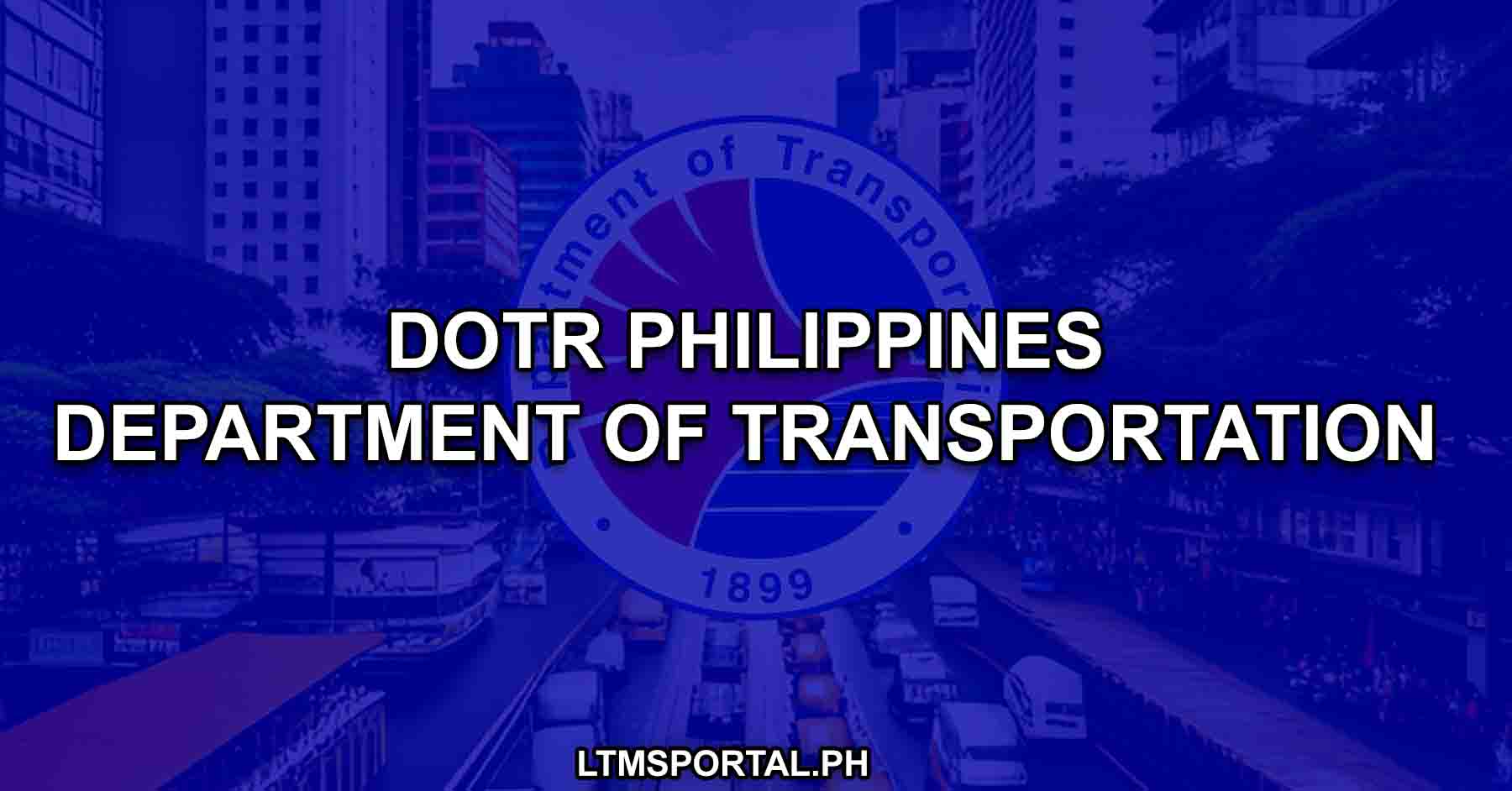
What is the DOTr
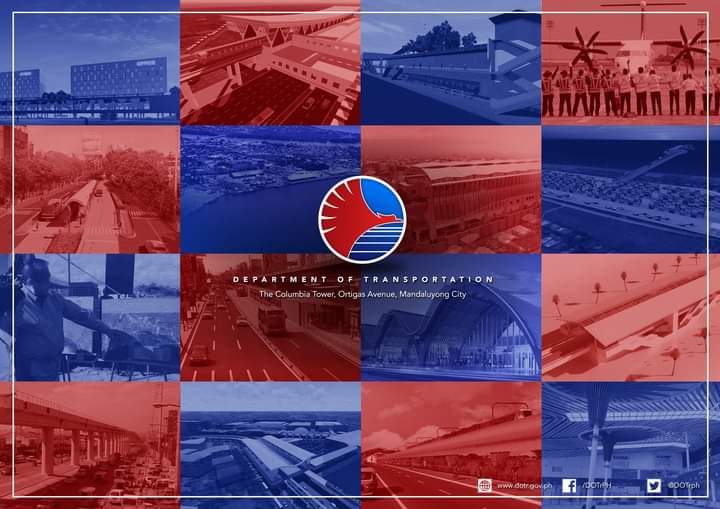
The Department of Transportation (DOTr) is the principal agency of the government, tasked with the responsibility of promoting, developing, and regulating a reliable and coordinated transportation network in the country. It was established on January 23, 1899, under the Malolos Constitution, and since then, the DOTr has been serving a pivotal role in accelerating the country’s economic development by providing efficient transportation infrastructure that connects islands and people, enhancing the nation’s competitive edge globally.
History
The DOTr’s roots trace back to the Department of Public Welfare in 1899, evolving through various incarnations. In 1979, it became the Ministry of Transportation and Communications (MOTC), setting the stage for focused policy, planning, and implementation in transportation and communication.
Subsequent reorganizations transformed it into the Department of Transportation and Communication (DOTC), ushering in an era of transformation and solidifying its position under the executive branch. As the agency weathered the ups and downs of history, it adapted to various changes and challenges, resulting in its current form as the Department of Transportation (DOTr).
DOTr Sectoral and Attached Agencies
Under the umbrella of the Department of Transportation (DOTr), various sectoral and attached agencies contribute to the implementation of projects across diverse domains. The DOTr oversees a spectrum of these agencies, ensuring the functionality and safety of different modes of transportation on land, air, and sea.
Logo of DOTr
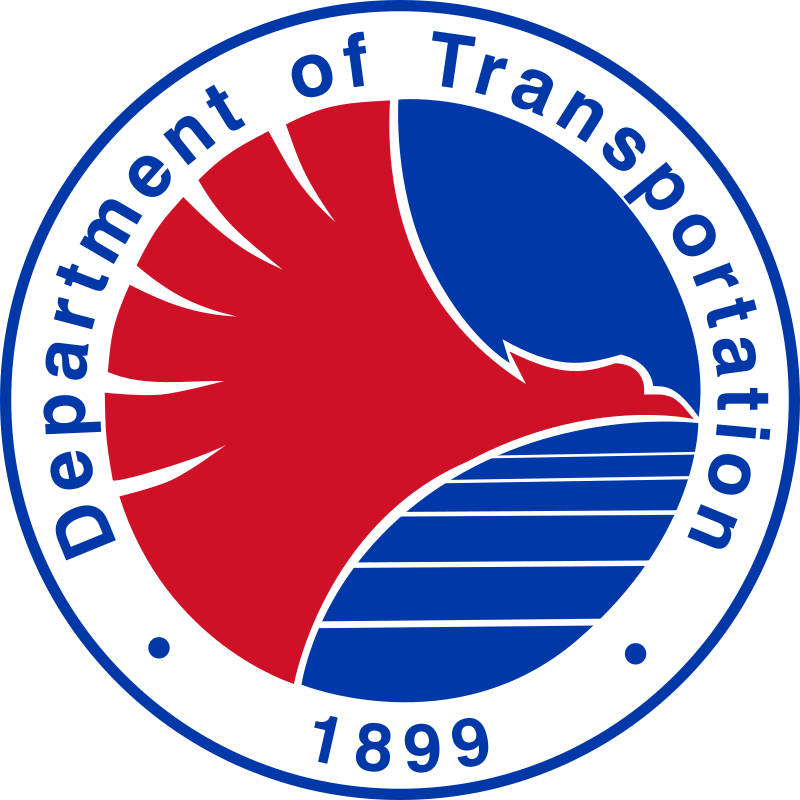
Sectoral Offices
Road Transport
1. Land Transportation Office (LTO)
[http://www.lto.gov.ph/]: Focused on ensuring the safety and comfort of the public, the LTO regulates, collects fees, and enforces laws related to motor vehicles.
2. Land Transportation Franchising and Regulatory Board (LTFRB)
[http://www.ltfrb.gov.ph/]: Established to simplify and maintain standards in the land transportation industry, the LTFRB ensures higher safety standards for land travel.
Maritime Transport
3. Philippine Coast Guard (PCG)
[http://www.coastguard.gov.ph/]: An armed and uniformed service tasked with enforcing laws in Philippine waters, conducting maritime security operations, and safeguarding life, property, and the marine environment.
Attached Agencies
1. Office for Transportation Security (OTS)
[http://www.ots.gov.ph/]: Serving as the single authority for the security of all transportation systems, the OTS covers Civil Aviation, Sea Transport, Maritime Infrastructure, Land Transportation, and Rail System and Infrastructure.
Civil Aviation
2. Civil Aviation Authority of the Philippines (CAAP)
[http://www.caap.gov.ph/]: An independent regulatory body with quasi-judicial and quasi-legislative powers, responsible for implementing policies and setting rules and regulations on civil aviation.
3. Manila International Airport Authority (MIAA)
[http://www.miaa.gov.ph/]: Created to provide safe, efficient, and reliable airport facilities, promoting the Ninoy Aquino International Airport (NAIA) as a center for international trade and tourism.
4. Clark International Airport Corporation (CIAC)
[https://ciac.gov.ph/]: Manages airport infrastructure and services to realize Clark Airport’s vision as the premier world-class airport in the Asia Pacific Region.
5. Civil Aeronautics Board (CAB)
[http://www.cab.gov.ph/]: Tasked with regulating, promoting, and developing the economic aspects of civil aviation, overseeing consolidations, mergers, and the leasing, purchasing, and selling of aircraft.
6. Mactan-Cebu International Airport Authority (MCIAA)
[http://www.mactan-cebuairport.com.ph/]: In charge of operating and maintaining airport safety and security, implementing rules and regulations at Mactan International Airport.
Road Transport
7. Toll Regulatory Board (TRB)
[https://trb.gov.ph/]: The TRB supervises and regulates the construction, operation, and maintenance of toll facilities in the country, including the collection of toll fees.
8. Office of Transportation Cooperatives (OTC)
[https://otc.gov.ph/]: Originally known as the Committee on Transport Cooperatives, it integrates transport cooperatives into the public transport system, aiming for economies of scale regarding fuel consumption.
9. Philippine National Railways (PNR)
[http://www.pnr.gov.ph/]: Created to provide a nationwide railway transportation system, with plans for new lines connecting developing areas to Metro Manila.
10. Light Rail Transit Transit Authority (LRTA)
[http://www.lrta.gov.ph/]: Oversees the construction and operation of the Light Rail Transit project, expanding its mandate to cover other light rail projects in Metro Manila.
Maritime Transport
11. Philippine Ports Authority (PPA)
[http://www.ppa.com.ph/]: Primarily concerned with planning and developing the country’s seaports, coordinating all ports nationwide, except those in Cebu.
12. Maritime Industry Authority (MARINA)
[http://www.marina.gov.ph/]: Oversees the promotion and development of the maritime industry, regulating shipping enterprises, issuing Certificates of Public Convenience, and enforcing maritime law.
13. Cebu Ports Authority (CPA)
[http://www.cpa.gov.ph/]: Administers all ports in Cebu Province, operating separately from the Philippine Ports Authority (PPA) system.
14. Philippine Merchant Marine Academy (PMMA)
[http://www.pmma.edu.ph/]: Formerly the Philippine Nautical School, it aims to produce efficient merchant marine officers with skills at par with international standards, contributing to international trade and serving as auxiliary naval officers during conflicts.
Project Management Office
15. Metro Rail Transit (MRT)
[http://www.dotcmrt3.gov.ph]: MRT3, known as the EDSA MRT or Metrostar Express, operates under a Build-Lease-Transfer contract with the privately owned Metro Rail Transit Corporation (MRTC). It spans 16.9 km along Edsa from North Ave., Quezon City, to Taft Ave., Pasay City.
Mission, Vision, and Core Values
The DOTr operates with a vision that extends to 2030, aiming to be a world-class organization with a commitment to environmentally sustainable and globally competitive and interconnected transport.
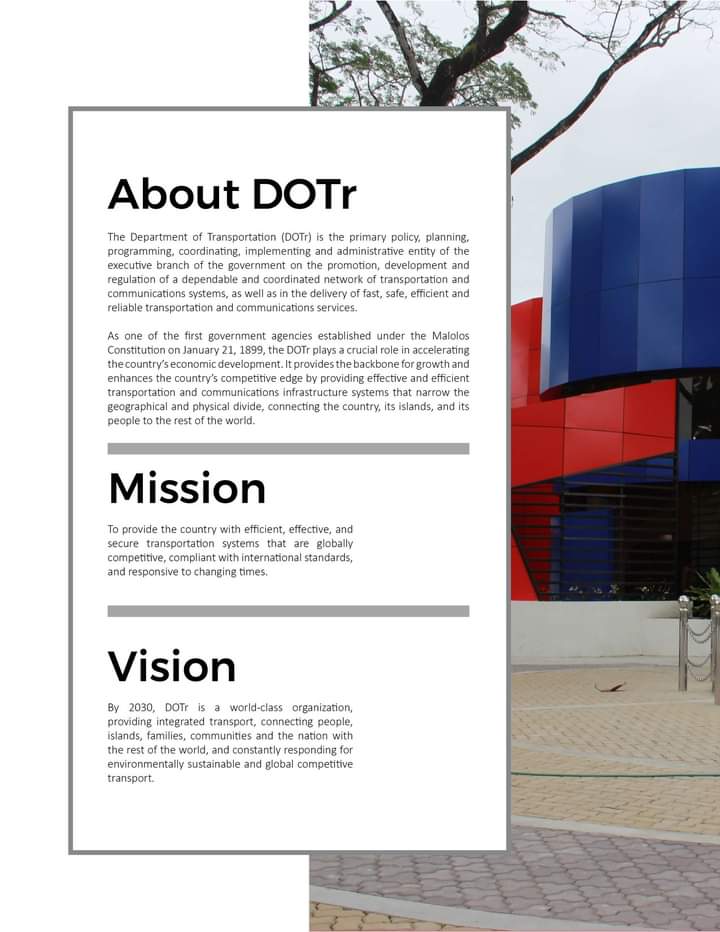
Upholding its core values requires knowing them, which is why we listed the values by which the agency shapes its operations in order to align with its broader mission of providing efficient, effective, and secure transportation systems compliant with international standards.
Core Values
As an organization, the DOTr upholds the following core values for the following reasons:
- Integrity and Honesty: Practicing honesty and integrity in formulating policies and utilizing resources in alignment with the DOTr’s mission and vision.
- Competence: Constantly seeking and applying new ideas, technologies, and practices to enhance service delivery to stakeholders.
- Timeliness and Right Conduct: Performing tasks with the right attitude and behavior at the appropriate time.
- Transparency: Providing stakeholders and the public with access to relevant information.
- Respect and Care: Treating stakeholders with utmost respect and care.
- Teamwork: Collaborating as a team to achieve common goals and objectives.
- Commitment to God: Entrusting everything to God for the continuous advancement of the Department and the nation.
DOTr Functions
Some of the DOTr’s key functions, include the following:
1. Policy Formulation
- Plans and improves national transportation policies and programs
- Implements traffic management strategies for both public and private vehicles
2. Industry/Services Regulation
- Promotes, develops, and regulates transportation and communication systems
- Regulates transportation-related industries and services, including toll gates, roads, and bridges
- Monitors and enforces traffic laws along with other attached agencies like the Metro Manila development Authority (MMDA) in policing road users and ensuring the observance of speed limits and parking regulations
3. Infrastructure Development
- Primary entity for government transportation matters
- Aims for fast, safe, efficient, and reliable transport and communication services
- Manages infrastructure development, including building, maintaining, operating, and controlling public works projects
4. International Cooperation
- Engages in international cooperation on transportation matters
- Represents the Philippines in international transportation forums such as the International Civil Aviation Organization (ICAO) and the International Maritime Organization (IMO)
DOTr Projects
The DOTr spearheads diverse programs and services, ranging from procurement and public bidding to alternative methods of procurement. The agency engages in various activities as well, all to showcase the DOTr’s commitment to transformative infrastructure development.
The following are some of the programs and services offered and initiated by the DOTr:
Procurement and Public Bidding
DOTr manages public bidding for government projects, providing information in advance on the website. They handle bid submissions, evaluations, and contract awards.
Alternative Procurement Methods
DOTr uses alternative methods like negotiated procurements, direct contracting, and competitive tendering for goods and services.
Blacklisting of Contractors
Contractors breaching terms, causing delays, or under investigation for corruption are blacklisted, preventing them from bidding for a specified period.
Foreign-Assisted Projects
DOTr manages competitive bidding for public works funded by foreign sources.
Public-Private Partnership (PPP) Projects
DOTr oversees projects financed by the private sector, starting with a request for proposal outlining project specifications.
Ongoing Projects
Metro Manila Subway
A project building an underground rapid transit line in Metro Manila.
PNR North-South Commuter Railway
A commuter rail project from New Clark City to Calamba, Laguna, with a 106-kilometer North Line expected to complete by 2021.
Build! Build! Build!
Under the presidency of Rodrigo Duterte, the DOTr embraced a robust infrastructure program known as Build! Build! Build! This initiative saw the implementation of numerous transportation projects totaling ₱3.6 trillion from 2018 to 2022
Changes, Development, and Future Directions
In 2016, the DOTr underwent a significant transformation with the creation of the Department of Information and Communications Technology (DICT). This led to the renaming of the department to the Department of Transportation (DOTr) from being DOTC. This was not a simple name change as it split the department into two, officially separating the transportation and the communication sector. It also moved its main operations to Clark Freeport and the Special Economic Zone, reflecting the agency’s adaptability and strategic planning.
Video: Recent Achievements of the DOTr
Watch this video from the DOTr and see for yourself how the agency has actively enhanced the country’s public transportation system in recent years. Its achievements include completing numerous airport, seaport, railway, and road infrastructure projects. Some of its major accomplishments include:
- airports
- Bicol International
- Clark International
- Bohol-Panglao
- seaports
- Cagayan de Oro
- Tagbilaran
- railway projects
- North-South Commuter Railway
- LRT-1 Cavite Extension
- road sector
- 500-km bike lane network
- Parañaque Integrated Terminal Exchange (PITX)
- Other initiatives:
- Service Contracting Program
- Free Ride for health workers.
Summary
The Department of Transportation (DOTr) in the Philippines stands as a vital force propelling the nation towards better mobility. It is not merely a bureaucratic entity; it is the lifeline that connects the archipelago through transport infrastructures, fostering easier access and faster economic growth, while satisfying the evolving transport needs of the commuting public. The DOTr also steers the nation on the road to progress, by ensuring the efficient operation and regulation of transport systems on air, land, and water, connecting people and places in the entire archipelago via efficient, safe, and globally competitive transportation systems.
Contact Information
For those who are seeking clarity on the DOTr’s role in public service as well as the services that they offer, the DOTr contact information listed here ensures direct access for inquiries or concerns, showcasing the DOTr’s commitment to transparency and public engagement.
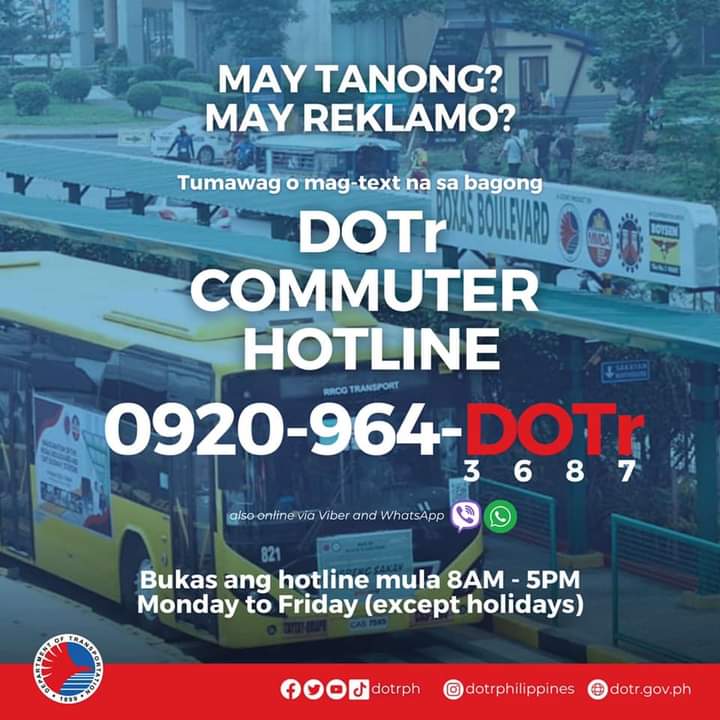
Here’s how you can reach the different DOTr offices in the country:
Department of Transportation (DOTr)
Office Address: The Columbia Tower, Brgy. Wack-wack, Ortigas Avenue, 1555 Mandaluyong City, Philippines
Official Website: www.dotr.gov.ph
Trunkline: 8790-8300/8790-8400
Department of Transportation (DOTr) – CAR Office
Office Address: 2nd Flr. Post Office Bldg., Upper Session Road, Baguio City
Email Address: dotc_car@yahoo.com
Department of Transportation (DOTr) – CARAGA Office
Office Address: Capitol Avenue, Butuan City
Email Address: dotr13caraga@gmail.com